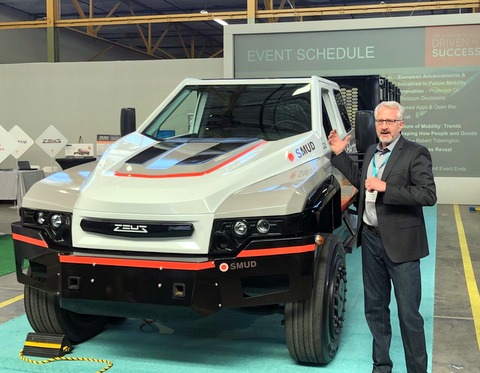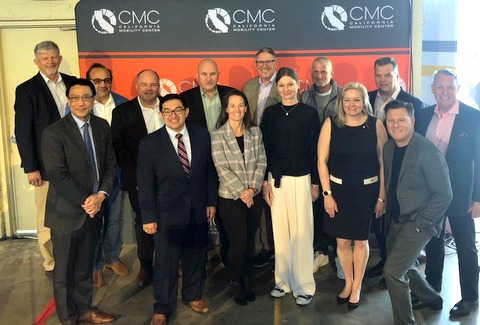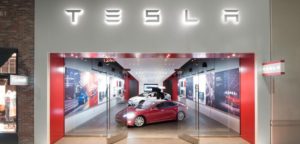California Mobility Center Helps Companies Contribute to States Transportation Transformation
Walking into the California Mobility Center’s first anniversary meeting, you might be struck by the bright-eyed, bushy-tailed energy of the men and women of a wide range of ages and their infectious enthusiasm for what they were presenting. But if you stepped back and went deeper you would hear about the path that led them to California Mobility Center.

The California Mobility Center (CMC) is an incubator, offering those with an idea help where they need it. Some may seek help with understanding how to take their concept of a viable mobility solution to a major problem and build it into a reality. For others, it may be help seeking critical initial financing or guidance from experienced hands who can point out potential pitfalls, specialists in a variety of old and new technologies and teachers who can provide assistance in material selection for software or hardware.
The world has lots of incubators. What differentiates CMC? CMC is a very different animal altogether. To dive deeper we talked with one of CMC’s supporters, Dr. Alberto Alberto Ayala, CEO of the Sacramento Metropolitan Air Quality Management District. He is a BS/MS/PhD engineer who had a key role that isolated the critical elements that yielded the undeniable evidence of Volkswagen’s cheating in the Dieselgate scandal. Quotes are from our exclusive interview with him.
California’s Secret Sauce
This thought process, applied to issues of transportation, the environment and the future of transportation allowed Ayala to understand and identify what he calls the “secret sauce” that makes the California ideal work and Silicon Valley spectacular success possible.
To more than half of the U.S. California is the Land of Fruit and Nuts. To the person with an idea, living in China working for billionaire Jack Ma in the company’s 996 program (work 9AM to 9PM, 6 days a week), California would be a dream. For the communications engineer in the Ukraine hooking up people in the field sending logistical information about the invasion to former hobbyist drone club flyers, Tesla’s Starlink was a lifeline created and implemented by California dreamers.
Democracy is messy. We sometimes can’t see the advantages. Working together, encouraging others to share their ideas and their needs, building consensus around concepts, none of this is easy. When you take this method and add American idealism, a Silicon Valley lack of inhibition and drive, you have a lot going for you.
But you still need Dr. Ayala’s “secret sauce.”

“California took the first step 32 years ago in 1990,” said Ayala. It hasn’t been easy, and it’s taken us a long time, but when you consider the type of development you have seen in California, in the U.S. and the world, you can trace it back to that very initial policy requirement (the mandate for automakers to produce zero emission vehicles). That essentially requires the manufacturers to bring these technologies to the market, right? So, imagine if we can create and frame policy in a way that supports not only EVs, but all of the other technology and mobility innovations that you see here in the CMC. And the other point is–and I argue that the makers of that technology need to see–if you are a manufacturer that is established at the CMC, and if you are an innovator that has a new solution; it behooves you to understand the role of policy and what policy instruments can do to support your technology.”
Ayala: “Because one thing we have understood, working on public policy here in California for a long time, is clear: public support, public dollars, public policy has a very important role to early market adoption. Incentivizing and enticing folks to become early adopters of technology.
“But we also understand that eventually it is the private sector, it’s the market that needs to support and create the demand for these technologies. Because the role of government is to create and support these markets, not to fund them forever.
“They need to become viable private enterprises. Look at Tesla, they don’t need public support anymore. Because they created the excitement and demand in the market–people cannot wait to get their cars. Imagine if we can create the combination of innovation, technology and policy for many of the zero emission and electric mobility solutions that we have here.”
Tesla’s Path

Dr. Ayala and his policy making colleagues in the legislature, the regulating agencies and the governor’s office envisioned a system where electric car manufacturers could sell their emission credits to those transportation manufacturers who couldn’t or wouldn’t build zero emissions vehicles.
Tesla took full advantage of what these forward-thinking policymakers created and, through selling the company’s emission credits creating income that pulled them though and allowed Tesla to profitably lead the huge shift in car manufacturing away from vehicles that that pollute our environment with their exhaust.
Ayala: “California instituted the very first requirement anywhere in the world that required automakers to produce and bring to the market electric vehicles. Policy is always catching up to technology,” but said California collaborated on “coalescing behind a single goal.”
The CMC Role
CMC represents one of the ways California continues to put incentives in place to encourage the creation of solutions that are as pollution-free as possible.
“There is no accident that Sacramento is the seat of government, and the state of California has been leading the environmental fight for many years. The policies that have helped create markets were born here.
“You’ve got folks that have these new ideas and the rest of us are here to understand the ideas and to better design the policies, or advocate for the policies, that best support these innovations. And now when you consider what is happening at the federal level the potential for impact from the CMC is even greater.”
The Government Role

Autocracies can order their people to do whatever they deem fit; the public is not given a choice or an opportunity. Unfortunately, the citizens of many nations do not have the opportunity to choose. We do. The CMC concept is like many other incubators, except that it also offers the opportunity for those with a vision to present their concepts to policymakers who can help by offering the very best of California’s version of the American capitalist system. “Because government–the role of government is to create and support these markets–not to fund them forever,” Ayala added.
Incentives that allow profits can help build economies of scale that allow products to be priced competitively. We can choose a lower-cost option that is environmentally sustainable and the company may remain profitable long after incentives are no required. What we do with our money is our choice. We choose. Through collaboration CMC will help us create these options.
One final quote from Dr. Alberto Ayala seems fitting: “Supporting the innovators at CMC is public policy at its best.”

purchase lasuna sale – diarex order himcolin online buy
buy besivance medication – purchase besivance buy sildamax tablets
buy generic benemid for sale – etodolac drug order carbamazepine pills
buy gabapentin sale – nurofen pills azulfidine usa
how to get colospa without a prescription – order arcoxia 60mg pills purchase cilostazol for sale
buy celecoxib – buy urispas no prescription indomethacin for sale online
buy generic diclofenac over the counter – order aspirin 75 mg without prescription order aspirin 75mg
cheap rumalaya generic – cheap shallaki generic amitriptyline 10mg without prescription
mestinon 60mg over the counter – mestinon 60 mg brand purchase azathioprine for sale
buy cheap diclofenac – nimodipine order buy nimotop sale
generic baclofen 25mg – order piroxicam 20 mg sale feldene price
order meloxicam 15mg generic – meloxicam price toradol uk
cyproheptadine over the counter – order tizanidine 2mg for sale tizanidine 2mg pill
accutane drug – deltasone order online order deltasone pills
order generic omnicef 300mg – clindamycin generic buy clindamycin online cheap
cost acticin – order retin online cheap purchase retin generic
metronidazole 200mg sale – buy metronidazole 400mg purchase cenforce online cheap
betnovate for sale online – buy cheap benoquin purchase monobenzone
cheap amoxiclav – augmentin tablet cost synthroid 75mcg
order cleocin pills – indomethacin 75mg uk order indocin 50mg generic
brand cozaar 50mg – cephalexin 500mg uk purchase keflex pills
buy eurax cream – aczone ca purchase aczone online
zyban 150mg cost – purchase shuddha guggulu online cheap buy generic shuddha guggulu over the counter
provigil 200mg without prescription – modafinil 100mg pill buy melatonin pills
buy prometrium tablets – clomiphene order online cheap clomiphene for sale
purchase capecitabine for sale – xeloda cheap danocrine order
purchase alendronate online cheap – order fosamax 35mg pill buy generic provera
buy cabergoline 0.5mg for sale – cabgolin usa purchase alesse online
г‚·гѓ«гѓ‡гѓЉгѓ•г‚Јгѓ« – 50mg/100mg – バイアグラ йЈІгЃїж–№ г‚їгѓЂгѓ©гѓ•г‚Јгѓ« и–¬е±ЂгЃ§иІ·гЃ€г‚‹
eriacta box – apcalis would forzest action
buy modafinil without a prescription – modafinil canada buy cheap generic combivir
stromectol 3 mg tablets price – tegretol tablet cost carbamazepine 400mg
promethazine us – lincomycin 500 mg brand buy generic lincocin 500 mg